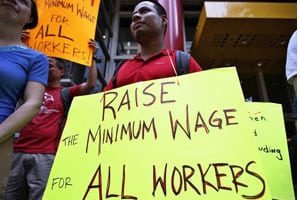 Last week’s Republican candidate debates failed to focus on the key issue of the minimum wage, which I think is brewing in this election cycle and in the general economy. We first wrote about this topic when Seattle adopted a $15 per hour minimum wage for restaurant workers in June 2014.
Last week’s Republican candidate debates failed to focus on the key issue of the minimum wage, which I think is brewing in this election cycle and in the general economy. We first wrote about this topic when Seattle adopted a $15 per hour minimum wage for restaurant workers in June 2014.
In recent weeks, media reports have sounded the alarm again about the possibility of a $15 per hour minimum wage. Independent presidential candidate Bernie Sanders supports raising it from the current $7.25 to $15. Senate Minority Leader Harry Reid (D-NV) and House Minority Leader Nancy Pelosi (D-CA) want to push the minimum wage to $12 per hour. President Obama has edged up his support from $9 to $10.10 and now $12. Hillary Clinton backed $15 per hour for New York fast-food workers on July 24 but hasn’t specified a wage floor for the nation.
From an implementation perspective, the full effect of proposed increases is often stair-stepped over three to five years. Budget experts and many Republican candidates warn such a hike could eliminate millions of U.S. jobs. We can see this becoming a 2016 presidential campaign topic as it resonates with low-income workers and seems to be popular with many people. From a compassion and human perspective, we all want people to earn more, but the pay should be in line with the job and productivity.
This year as we help clients perform operational assessments to reduce costs and improve productivity the wage issue is being voiced as a concern on a regular basis. This column is NOT meant to be political or a scare topic. If you haven’t already, spend a couple minutes thinking strategically how major increases in minimum wage would affect your company’s expense structure and profitability. What business process changes will you make to offset this?
A large multichannel distribution center client with sales in excess of $200 million employs about 275 full time equivalents (FTEs) during the year, at an average wage of $10.50 per hour. Every $1 increase in wage rate results in an incremental cost of $418,000 annually. Obviously, there are other administrative personnel which may be affected as well. For this company, an increase to a $15 minimum wage would mean a 42.8% increase in labor costs.
In our experience, increases in DC productivity (i.e. orders, lines, units processed per hour) haven’t risen to the point where an increase in wage rates wouldn’t be a financial disaster.
To be prepared to soften the blow from any federal minimum wage increase, here are 5 ways to increase productivity that some companies are considering:
Productivity reporting: Consider implementing productivity standards and reporting throughout your fulfillment processes. Many companies have limited productivity reporting, with most reporting hourly pick rates (units or pieces), pack rates (customer packages) and ship rates. Formalize productivity reporting by department and employee. There are often accuracy issues, especially with employees that are cross utilized in multiple departments.
Add automation and technology: What material handling equipment and automation will generate an ROI that can help offset these increases? For example, voice-enabled technology can increase the work pace and therefore productivity in all areas of DC operations (receiving, picking, returns, cycle counting, put away and replenishment).
Overhaul your current processes: How can you simplify your fulfillment processes to reduce the number of touches, thus cutting costs, boosting throughput and improving customer service?
Investigate incentive pay: If many of your DC jobs are based on incentive pay, you’ll have a formalized process for increasing productivity now and in the future.
Consider using a third-party fulfillment partner: In the long term, should you continue using internal resources only? Do a comparison study of 3PF costs to your internal fully-loaded costs. Can a 3PF reduce your cost per order, per line and per unit, as well as outbound shipping costs? Can it drive customer service improvements?
Now is the time to think strategically about current and future wage rates. As there will most likely be some type of national minimum wage increase in the foreseeable future, it’s not too early to start to identify what types of solutions can give you the best ROI.
Curt Barry is president of F. Curtis Barry & Company
